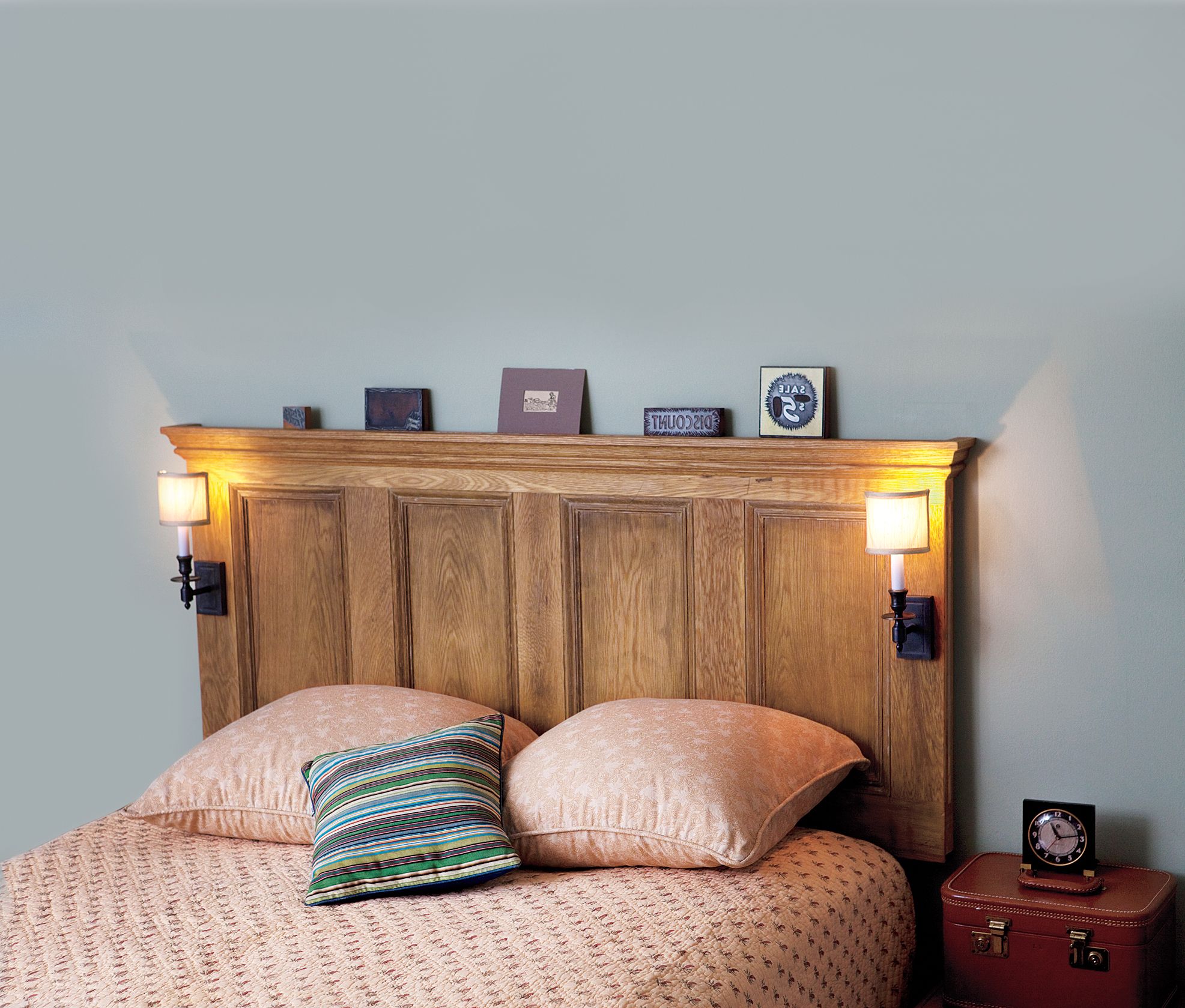Project details
Skill
Cost
Estimated Time
*Costs in this article sourced from Angi.
 Tape measure
Tape measure combination square
combination square Circular saw
Circular saw Steel straight edge
Steel straight edge Clamps
Clamps Hammer
Hammer Putty knife
Putty knife Random orbit sander
Random orbit sander Shop vacuum
Shop vacuum Drill/driver
Drill/driver paddle bit – 3/8-inch
paddle bit – 3/8-inch Brad nailer
Brad nailer N100 dust mask
N100 dust mask Safety glasses
Safety glasses
Transforming an interior door into a headboard is a creative and cost-effective way to add character to your bedroom. This DIY project allows you to repurpose an old door, giving it new life while creating a unique headboard for your bed. In this guide, we’ll walk you through the process of selecting, preparing, and transforming an interior door into a stunning headboard.
Choosing the Right Door for Your Headboard Project
The door you choose will significantly impact your headboard’s final look and functionality. Consider the door’s style and size to ensure it complements your bedroom decor and fits your bed appropriately.
Types of Interior Doors Suitable for Headboards
When selecting a door for your headboard project, look for solid wood doors, particularly those from homes built before 1950. These doors typically feature durable materials such as oak, maple, chestnut, or mahogany, providing a sturdy base for your headboard.
Panel configurations are an important factor to consider. Opt for doors with evenly spaced squares or rectangles of the same size and shape to ensure symmetry when the door is horizontal.
Craftsman-style five-panel doors with rectangles stacked vertically like ladder rungs are ideal for this project. Art Deco-style doors with a single recessed panel in the center can also work well. These styles offer interesting visual elements that can enhance the overall design of your headboard.
Measuring and Sizing Considerations
Door height is crucial in determining whether a door will fit your bed. Most interior doors range from 70 to 96 inches in height.
For a standard king-size bed (76 inches wide), you might find a door that fits perfectly without modification. However, for smaller bed sizes, you’ll likely need to trim the door to achieve the right proportions.
To determine how much to trim off, measure your bed’s width and compare it to the door’s height. For example, if you have a queen-size bed (60 inches wide), you’ll need to cut the door down to size.
When trimming, consider removing equal amounts from both the top and bottom of the door to maintain its original proportions and design elements.
Essential Tools and Materials to Create Your Headboard
Gathering the right tools and materials before starting your project will ensure a smooth transformation process. Having everything on hand will help you work efficiently and achieve professional-looking results.
Required Tools
To complete this project, you’ll need the following tools:
- Brad nailer
- Circular saw
- Clamps
- Combination square
- Drill or driver with a 3/8-inch paddle bit
- Hammer
- N100 dust mask
- Putty knife
- Random orbit sander
- Safety glasses
- Shop vacuum
- Steel straight edge
- Tape measure
Necessary Materials
In addition to tools, you’ll need these materials:
- Crown molding (if desired)
- Finishing nails
- Furniture polish (such as Old Craftsmen’s Lemon Oil with Bees Wax)
- Interior door (solid wood preferred)
- Mounting hardware
- Paint or stain
- Sandpaper (various grits)
- Sconces (if adding lighting)
- Wood filler or putty
- Wood glue
9 Steps to Transformation Your Door Into a Headboard
Proper preparation is crucial to creating a beautiful and long-lasting headboard. This stage involves removing any hardware, filling holes, and ensuring the surface is smooth and ready for customization.
Step 1: Wood Interior Doors
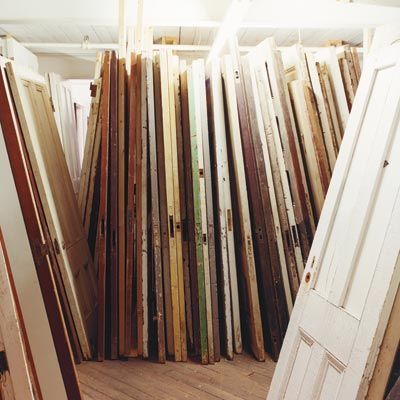
Panel configuration is the first factor to consider when shopping for a door to convert. Be sure to pick one with evenly spaced squares or rectangles of the same size and shape. That way, the design will be symmetrical when you turn the door on its side.
Craftsman-style five-panel doors with rectangles stacked one on top of the other like ladder rungs are ideal, as are Art Deco-style doors with a single recessed panel in the center.
For this project, I chose a ladder-type door in oak from The Demolition Depot in New York City.
Step 2: Measure the Door
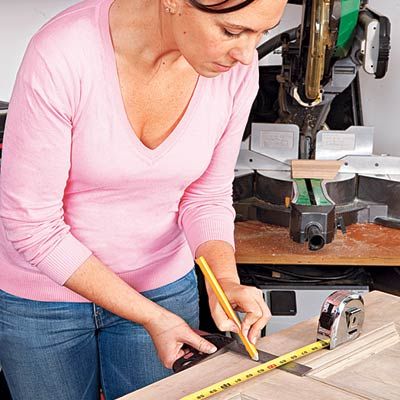
Door height is also key. Most doors are between 70 and 96 inches in height. While you might be lucky enough to find a match for a standard 76-inch-wide king-size bed, you’ll have to cut one down for anything smaller. To fit my 60-inch queen bed, I took trimmed sections from both the top and bottom of my door to maintain its proportions.
Use a combination square to trace the cutlines.
Step 3: Slice Off the Overage
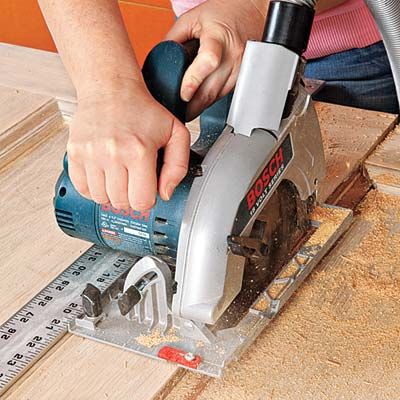
Use a circular saw to cut the door to size. Place a straightedge alongside your cutlines to create a guide fence for the saw and clamp it to the door.
Step 4: Patch Holes
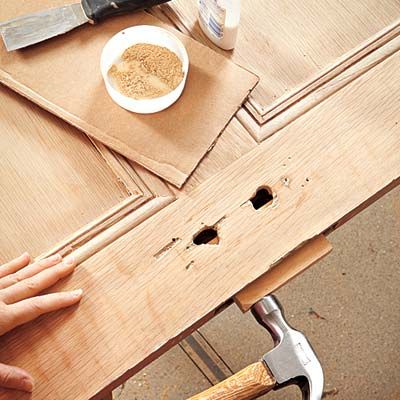
Tap in a wood scrap to fill the void in the edge of the door where the lock used to be. For the surface holes, make a matching putty out of glue mixed with sawdust left over from your offcuts. Spread with a putty knife.
Step 5: Sand the Surface

For stripped doors like mine, remove splinters and round rough edges with a random-orbit sander. For painted ones, first remove the old finish with a liquid stripper; dry stripping can release toxic lead dust into the air.
Step 6: Cut Crown for the Top
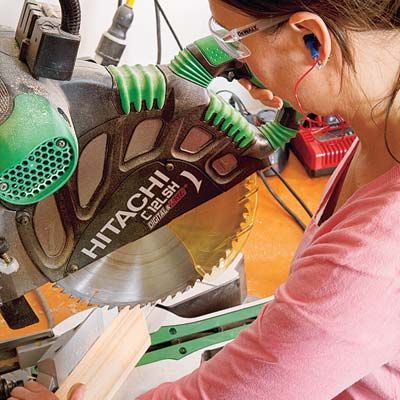
Mark the length of the door’s face on a strip of solid crown molding. Cut to size, mitering the ends at 45-degree angles. Use the offcuts to create decorative returns for the door’s outside edges.
Step 7: Secure the Crown
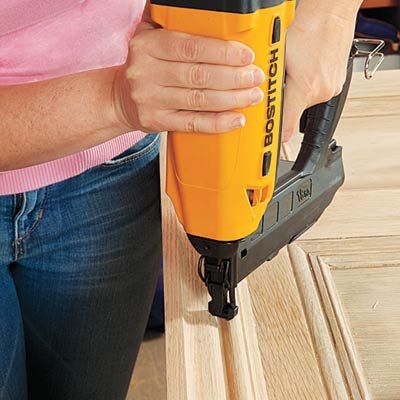
Squeeze a bead of glue on the crown’s back side and press it into place. Reinforce the bond by tapping in finishing nails about every 6 inches. I used a brad nailer to speed up the process.
Step 8: Seal the Wood
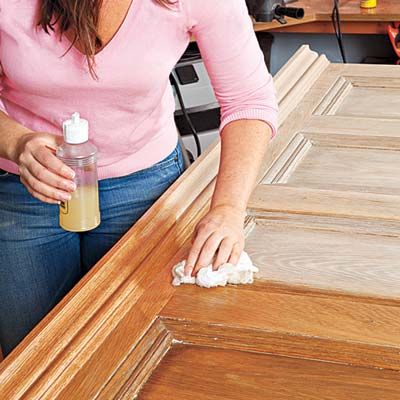
To restore the door’s luster and highlight the grain pattern, apply a natural furniture polish like Old Craftsmen’s Lemon Oil with Bees Wax.
About $7; Amazon
Step 9: Install the Sconces
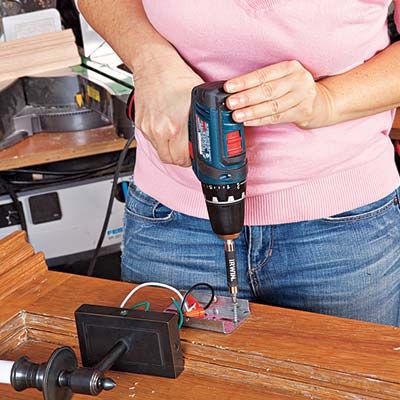
Mark where you want the fixtures to be. Fit a drill or impact driver with a paddle bit and bore holes through which to fish wires. Secure the sconces’ back plates to the door using the screws provided, and hook up the lights.
Now it’s time to hang your new headboard.
Mounting Your New Headboard
Proper mounting is crucial for both the safety and aesthetics of your new headboard. I recommend the following methods.
Creating a Sturdy Mounting System
A French cleat is an excellent DIY method for hanging your door headboard. This system consists of two beveled pieces of wood that interlock, with one attached to the wall and the other to the headboard. This method distributes the weight evenly and allows for easy installation and removal.
Proper Wall Attachment Methods
When attaching the wall side of the French cleat, ensure you’re anchoring it into wall studs for maximum stability. Use a stud finder to locate the studs, and use appropriate screws to secure the cleat. If studs aren’t available in the desired location, use heavy-duty wall anchors rated for the weight of your headboard.
Design Ideas for Door Headboards
Your door headboard can be more than just a decorative element. With some creative thinking, it can also serve functional purposes in your bedroom.
Incorporating Shelving or Storage
Consider adding small shelves to the recessed panels of your door headboard. These can serve as nightstands or display areas for books, plants, or decorative items. For deeper doors, you might even be able to create hidden storage compartments within the door’s structure.
Using Multiple Doors for Larger Beds
For king-size beds or to create a more dramatic effect, consider using multiple doors side by side. This approach allows for interesting design possibilities, such as alternating door styles or creating a triptych effect with painted designs spanning across all the doors.
Creative Finishing Touches for Your Headboard
Incorporating artistic touches can add a unique flair to your door headboard. Hand-painted details, decals, or contrasting inlaid patterns can dramatically enhance the look.
Remember, each added element should complement the overall aesthetic without overwhelming the design.
Hand-Painted Designs
Hand-painting intricate designs or motifs on the panels can add a personal touch that stands out. Use stencils if freehand drawing isn’t your strength. Opt for patterns that resonate with your bedroom’s theme—whether floral for a cozy, cottage vibe or geometric shapes for a modern, sleek look.
Decals and Inlay
Decorative decals are an easy way to create a polished finish. Choose from a variety of designs available in craft stores. Additionally, wood inlay techniques using different wood tones can craft a stunning, high-end appearance, giving your headboard an artisan feel.
Maintaining Your Door Headboard
Proper maintenance will ensure your door headboard remains beautiful for years to come.
Cleaning and Dusting Tips
To prevent buildup, regularly dust your headboard with a soft, dry cloth. For deeper cleaning, use a slightly damp cloth, taking care not to oversaturate the wood.
Avoid harsh chemical cleaners that could damage the finish.
Touching Up Finishes Over Time
Over time, you may notice wear on your headboard’s finish. For painted headboards, keep some touch-up paint on hand for quick fixes. For stained headboards, periodically apply a fresh coat of furniture polish to maintain the wood’s luster and protect its surface.
Our Conclusion
By following the steps outlined in this guide, you can create a unique, personalized headboard that serves as a stunning focal point in your bedroom. The result will be a beautiful, one-of-a-kind headboard that adds character and charm to your bedroom for years to come.
Sconces: Studio Single French Library Sconce in bronze finish by Visual Comfort
About $126 each; Neena’s Lighting
